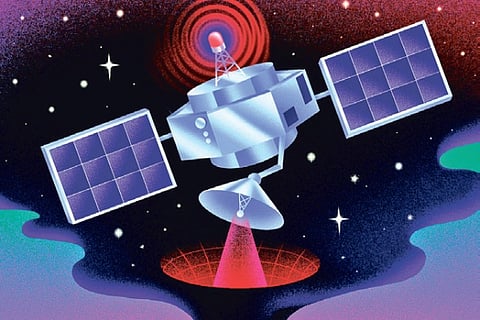

Chennai
We are playing Russian roulette with extreme climate events.
Look no further than Texas, where extreme cold from the warming Arctic descended and blanketed the state and much of the rest of the nation last week in freezing temperatures.
But frigid weather in that unlikely locale isn’t all we should worry about. What’s happening to the climate presents unpredictable weather risks that, as we’ve seen time and again, can be extremely dangerous and strike almost anywhere.
In fact, the United States had an average of around six heat waves a year in the past decade, at times breaking local temperature records. Last year a town in north-eastern Siberia reportedly reached 100 degrees Fahrenheit. The western United States found itself engulfed by smoke-filled skies and raging wildfires. The summer of 2019 saw sprawling heat waves in Europe, and temperatures hit 123 degrees Fahrenheit in part of the Indian subcontinent.
Because of climate change, extreme hot and cold weather events and ramped-up storms are becoming more frequent, more intense and often longer lasting. The recent glacier collapse in India is a stark reminder of how warming temperatures can contribute to catastrophic outcomes.
It is not a question of if but when an extreme event will reach your neighbourhood. That’s very hard to predict. To safeguard our communities, scientists need to be able to see a couple of months or more ahead. With a deeper understanding of the science and better technology, that may be possible. But we don’t have all of that in place now.
That’s not to say scientists haven’t significantly improved weather forecasting. They have, thanks to government and private investments in satellite and ground-based measurements and the development of advanced computer models. It’s now possible to predict weather events like cold snaps and storms up to about two weeks in advance. But things become much less clear beyond that.
Climate scientists, on the other hand, can estimate environmental conditions decades into the future. This creates a gap in the time scales between forecasting weather and climate. Nature has no such artificial demarcation. Recent observations suggest worrisome trends that underscore the interplay between weather and climate.
Among the two dozen or so satellites that NASA operates to monitor Earth’s environment, two of them — the Orbiting Carbon Observatories 2 and 3 — track sources of carbon dioxide and natural absorbers of that greenhouse gas, called sinks. The decades-old technology in these two satellites samples less than 1 percent of Earth’s surface each month. But even these sparse measurements are revealing some staggering changes in Earth’s carbon cycle.
We think, for instance, of the Amazon forests as giant sinks that suck in carbon dioxide from the atmosphere. That was once true. However, after decades of increased warming, sporadic rainfall, escalating fires and deforestation, research suggests that the Amazon is gradually turning into a source of carbon dioxide. Sub-Saharan Africa is becoming a source as well, as higher temperatures enhance plant respiration and reduce the efficiency of photosynthesis.
At the same time, across the Arctic, permafrost is thawing, raising alarms that the warming ground could release an enormous cocktail of greenhouse gases into the atmosphere. The well-founded fear is that this will create a positive feedback loop, fuelling and accelerating global warming.
What’s clear is that Earth’s carbon cycle is changing. It’s worrisome that we don’t fully understand how these changes are shaping Earth’s future in the short term. Our current capability for sporadic observations could easily miss small changes in the climate system — the so-called tipping points — that could cascade into catastrophes.
We urgently need an international partnership to develop a high-resolution and high-fidelity Earth observation system. This would involve new satellites and ground-based monitoring stations that feed their data to high-performance computers to predict events.
Recent efforts are attempting to fill the predictive gap with a combination of physics-based and artificial-intelligence-based models. But near-real-time measurements are needed to increase forecasting accuracy. Today’s capabilities are woefully inadequate to provide that data because the majority of Earth-observing satellites are operating well beyond their design lifetimes and most of those have no replacements planned.
With its intense focus on climate change, the Biden administration should convene climate scientists in federal and state agencies, national laboratories, academia, the private sector and non-profits to draft a plan for an advanced Earth observation system. The idea would be to sharpen our ability to monitor the environment, make the data available to the scientific community and expand our predictive capability well beyond what it is today to forecast extreme weather events generated by the warming climate.
As a bonus, this new system could also verify whether countries that signed the Paris climate agreement are meeting their goals to limit their greenhouse gas emissions.
Russian roulette is a dangerous game. The chances of tragedy are high. So are the perils in the short term with climate-influenced weather events. That’s why we need an early warning system that can identify the locations and magnitude of these threats. The return on these investments will be in lives and economies saved. It ought to be a top priority for global cooperation.
Abhishek Chatterjee is an earth scientist with the Universities Space Research Association; William Collins is a professor of earth and planetary science; Arun Majumdar is a professor of mechanical engineering at Stanford. NYT©2020
The New York Times
Visit news.dtnext.in to explore our interactive epaper!
Download the DT Next app for more exciting features!
Click here for iOS
Click here for Android